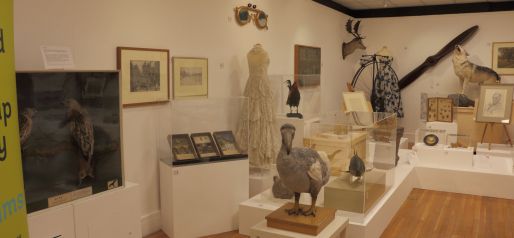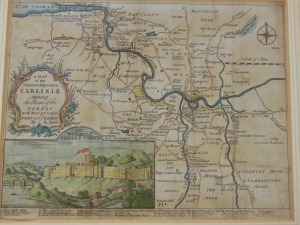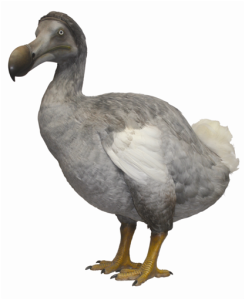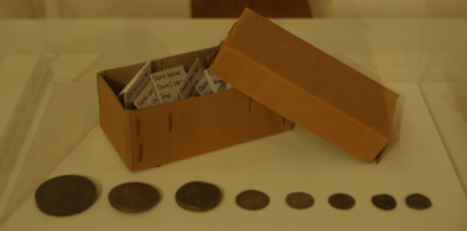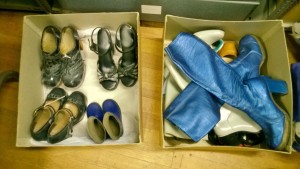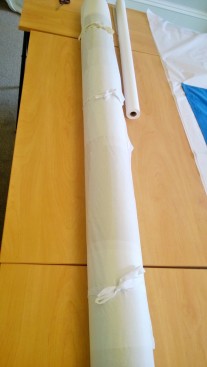Blog Archives
Volunteers – Caldew School NCS Students Get Involved
On Saturday 28 November, the volunteer programme were delighted to welcome 22 pupils from Caldew School to complete a day of ‘Social Action’ at Tullie House as the culmination of their National Citizen Scheme Award.
Nicky and John tell us about their day at Tullie and the work towards their award.
Last Saturday we completed our social action project at Tullie House Museum. As a group we developed and participated in three activities. The focus of the day was thinking about visitors from the community with visual impairment. This meant that one group created a sensory space in the garden, and another group researched and wrote scripts then recorded audio ‘labels’ for the Social History gallery. Finally the third and smallest group produced an NCS display, highlighting what the NCS programme involves and has to offer all young people.


To give you some background, the NCS stands the National Citizen Service award and is open for all 16-17 year olds across England and Wales. It is a journey through a series of phases with its ethos being based on:
- Challenge
- Responsibility
- Inspiration
- Social mix
- Independency
- Social action
All of us who complete the NCS journey are awarded with a certificate signed by David Cameron (prime minister). However the skills and knowledge that we gain on the route are extremely valuable to wherever our futures lead.
We are all year 12 pupils from Caldew School. The start of the course saw us go to Lockerbie Manor, an outdoor pursuits centre where we did a range of activities designed to build up our confidence and communication skills. Then over the Autumn half term we visited various places within Carlisle and improved our understanding of the local community. We also took inspiration from the local organisations which eventually led us to taking part in a social action project at Tullie House Museum.
Davie, one of the students summed their wish to participate perfectly saying “I’m here to give something back to the community” a sentiment echoed by all the students.
John Sander the NCS Co-ordinator from Carlisle United had these further comments to make:
“I am thrilled that the group have chosen to work in partnership with the city’s leading tourist attraction. The confidence and inspiration they will gain as this project develops will not only have a big effect on their futures but it will be something that they will always remember. Hopefully their endeavours both in raising the funding and then working at the museum will also have a long, lasting and beneficial effect on the city and people of Carlisle”
John Sander added:
“For most of these sixth formers who attend Caldew School the NCS journey has been a life changing experience. This relatively new government initiative has improved their employability and allowed the young people to build friendships and memories on both the away and home residential experiences that will last for ever. The work at Tullie House is now the icing on the cake that allows all these students to graduate”
What Nicky and John didn’t mention in their text above is that they also carried out fundraising that meant Tullie House was able to benefit from £200 worth of plants for the garden and further £600 for the museum. It is my intention to see these funds used to continue the work you have started.
I was very pleased to host these students and enable them to complete their award. In addition, they have made a real contribution to their museum and created superb resources for visitors to enjoy for years to come. It was a privilege for me work with these students who gave up their Saturday and worked solidly throughout the day to achieve their aims – even in the rain! Well done and thank you all!.
Claire – Volunteer Co-ordinator
#askthecurators Dodo Roadshow Special
On Saturday we had a very special visitor to our What’s in Store: The Curator’s Choice exhibition. As part of their roadshow from Land’s End to John O’Groats, the Oxford University Museum of Natural History brought their world famous dodo to Tullie House.

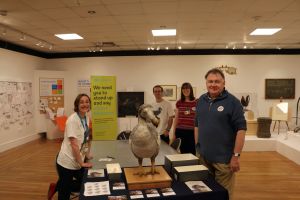 We took the opportunity to get a a few of our questions answered by the dodo’s minders, Paul, the Museum’s Director, Phil, Collections Assistant and Michelle, from the Front of House team.
We took the opportunity to get a a few of our questions answered by the dodo’s minders, Paul, the Museum’s Director, Phil, Collections Assistant and Michelle, from the Front of House team.
Where and when did dodos live?
Dodos lived in Mauritius which is a small island east of Madagascar in the Indian Ocean, famous for it’s white, sandy beaches. Dodos were discovered in 1598 by Dutch sailors.
Why did dodos become extinct?
It is a common misconception that dodos were hunted to extinction. They were hunted but when the Dutch discovered Mauritius they settled and introduced pigs to the island. The pigs competed with the dodo for their food (fruit) and also dodos nested on the ground and the pigs ate their eggs. The dodo was extinct by 1662 – less than 70 years after it was discovered!
 What did dodos eat?
What did dodos eat?
Dodos are thought to have predominantly eaten fruit.
Do you think we’ll ever find dodos living somewhere else we haven’t looked yet?
No – they are gone for ever.
Are there lots of dodos in museums?
There are quite a few casts and models but only a handful of specimens were brought to Europe. Museums in Cambridge and London have fossils, but Oxford University NHM has one of the few specimens that arrived in Europe. Another real skull is in a museum in Copenhagen.
How do we know about dodos?
Dodos were easy to catch being flightless. If one was caught it would scream and others would come running making them an easy catch. We now know, from DNA analysis, that dodos were members of the pigeon family.
A huge thank you to our guests and their star exhibit. They also asked some questions about our 1840 Portinscale red kites – you can see the answers on their blog
#askthecurators Dodo Roadshow Special
This Saturday (13 June) come and see a famous Dodo as part of our What’s In Store: The Curator’s Choice exhibition this between 10am and 11am at Tullie House. To celebrate we will be posting a Dodo Roadshow #askthecurators Special!
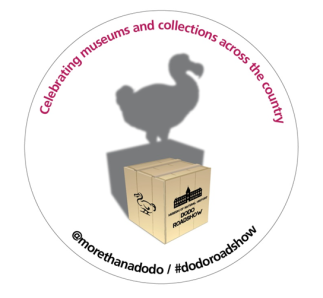 The flying visit to Carlisle is part of Oxford University Museum of Natural History’s Dodo Roadshow from Lands End to John O’Groats. The Oxford staff will be displaying the Dodo model from the Museum’s displays; a cast of the precious head, which is the only remaining soft tissue material of a Dodo in the world; and real foot bones from the same animal, representing some of the few organic pieces of Dodo remains.
The flying visit to Carlisle is part of Oxford University Museum of Natural History’s Dodo Roadshow from Lands End to John O’Groats. The Oxford staff will be displaying the Dodo model from the Museum’s displays; a cast of the precious head, which is the only remaining soft tissue material of a Dodo in the world; and real foot bones from the same animal, representing some of the few organic pieces of Dodo remains.

This is your chance to #askthecurators about the dodo and the Tullie House star object it is coming to meet, the 1840 Portinscale Red Kite from Tullie’s Collections, one of the last of Cumbria’s indigenous red kites and oldest mounted bird specimen in our collection.
Either come along on Saturday morning from 10-11am (suitable for all, usual admission charges apply) or #askthecurators your questions about the Dodo or Red Kite to @tulliehouse on Twitter and Facebook.
As the dodo started out on its road trip, we asked it a few questions of our own…
So, tell me about yourself – who are you and where do you come from?
I’m the famous Oxford Dodo. I spent most of my life on the tropical island of Mauritius in the Indian Ocean. Sailors arrived on the island in the late 16th century and everything changed. My life from then on is a bit of a blur, but somehow I appeared in Oxford around the 17th century and have been a museum treasure ever since.
What is it that makes you so special?
I’m a one off. Nowhere else in the world is there a Dodo with any flesh, but I’ve still got skin on my head and even a few little feathers, so scientists are fascinated by me. Dodo skeletons pop up in a few other museums, but it’s my skin that makes me really special. I was also used by scientists to explore Dodo DNA. Turns out I’m closely related to a pigeon! I’m literary too – I inspired Lewis Carroll’s Dodo character in Alice’s Adventures in Wonderland.
Who looks after you in Oxford?
My guardian is none other than the Head of Life (Collections). Darren Mann looks after all of the Life collections in the Museum and makes sure I’m stored safely so I last another 350 years.
Do you remember life before the museum?
I know I haven’t always been in this building. In fact, 200 years before this Museum was built, I was on display at the Ashmolean Museum – the first public museum in Great Britain. I was lucky to survive with any skin left intact; back then visitors were allowed to touch me and some of them gave me some pretty rough treatment.
What does the future hold for you?
Who knows what scientists have lined up for me next? A few weeks ago I was taken up to the University of Warwick for a fancy new CT scan. Apparently they found out something pretty exciting, which they’ll be able to reveal soon. But right now, my head is out on display in the Museum’s Presenting… case near the entrance; so if you’re in Oxford before 19 July stop by and say hello!
It will be the dodo’s chance to ask our Red Kite these questions on Saturday – but what questions do you want to ask?
#askthecurators Even More Questions Answered!
Following out Natural Science special our curators have been racking their brains to answer more of your great questions on our #askthecurators board in What’s in Store: The Curator’s Choice exhibition.
First up, Tim our Curator of Archaeology is tackling Caitlin’s question How do you make pottery, can you do a fun day where you make pottery?
 “Pottery is made of clay which is a sticky type of soil which is often found near rivers and lakes. This is collected and all the bits of twig as well as stones are removed. It is then thumped to make a block that has no air bubbles in it. It is now ready to use. The block is then shaped into the kind of pot that you want, such as a bowl or a jug. This is allowed to dry out and then it is ready to be fired. The pot is placed, with others that have been made into a type of oven called a kiln (although it is possible to use a bonfire, a kiln is more efficient). The kiln is then heated up slowly to over 1000 degrees centigrade. This causes chemical changes in the clay, making it hard and water resistant. The kiln is then allowed to cool and the pottery is removed. It can be used as it is or be decorated with a glaze. Glazes are chemical coatings that stick to the surface of the clay and give a shiny surface that is waterproof as well as being decorative. The pots are heated in the kiln again to make these chemical changes happen. Finally when they are cool, they are ready to be sold and used. Pottery is very long-lasting as pieces have been found in Cumbria that are over 3000 years old, and the basic process has always been the same. Pottery is very fragile and easily broken so it is usually the pieces rather than the complete pots that survive.”
“Pottery is made of clay which is a sticky type of soil which is often found near rivers and lakes. This is collected and all the bits of twig as well as stones are removed. It is then thumped to make a block that has no air bubbles in it. It is now ready to use. The block is then shaped into the kind of pot that you want, such as a bowl or a jug. This is allowed to dry out and then it is ready to be fired. The pot is placed, with others that have been made into a type of oven called a kiln (although it is possible to use a bonfire, a kiln is more efficient). The kiln is then heated up slowly to over 1000 degrees centigrade. This causes chemical changes in the clay, making it hard and water resistant. The kiln is then allowed to cool and the pottery is removed. It can be used as it is or be decorated with a glaze. Glazes are chemical coatings that stick to the surface of the clay and give a shiny surface that is waterproof as well as being decorative. The pots are heated in the kiln again to make these chemical changes happen. Finally when they are cool, they are ready to be sold and used. Pottery is very long-lasting as pieces have been found in Cumbria that are over 3000 years old, and the basic process has always been the same. Pottery is very fragile and easily broken so it is usually the pieces rather than the complete pots that survive.”
In terms of pottery fun days, we have run sessions on making pottery before—coming up we have a drop-in session to make clay tiles as part of our Eye for Colour opening weekend on Saturday 27 June, from 1pm until 4pm.
On a similar note another visitor asked Can you do a fun day for over 12 year olds? Thanks for you very much for your question. We have family fun days at the start of family exhibitions and at Christmas with activities for all the family. We also have a two Tullie Time Travellers club, one on Wednesdays from 4pm – 5.30pm, and another once a month on a Saturday from 1pm-3pm, especially for 10-14 year olds and our Yak Yak Youth Group for 14-19 year olds meet once a month on a Saturday.
Tim, our Curator of Archaeology and Edwin, our Curator of Social History have been thinking about some really tricky questions from Charlotte and Caitlin, first Charlotte asked What is your favourite thing here and why?
Edwin answers
My favourite thing at Tullie isn’t a ’thing’ as such, it is probably the sense of place captured in the museum. This is hard to define but it involves the coming and going of exhibitions, the familiar and less familiar objects, our diverse museum disciplines, the interaction of visitors and the past and present staff who make it all come together. I am proud to be a Curator here and part of the museum’s very own history.
Tim answers
I like the selection of coins that are on display. I think it is a great example of someone coming up with a really good idea – standardised pieces of metal that can be exchanged for ‘stuff’. I love the way the basic idea has not changed for over 2000 years. It is also fascinating to see how the idea has been used in different ways – design, metal used, size, way the coins are made – at different times. Also some of the designs are good examples of miniature works of art.
Caitlin set our curators a very tricky question, asking Why do people go to Tullie House?
There is no one answer to this question. I go to museums when I am on holiday for many reasons and I think that some of them are the same as why people come here. I go to see things I have read about in books or seen on the internet as well as to see new things. Often the buildings themselves are interesting. With some museums, it is a case of nostalgia when you see something that you used to own (or your parents used to own) and it brings back memories.
People come to the museum for a variety of reasons. Some may come with their family on a day out. Others make specific visits to see a particular object or examine collections and historic themes in more detail. Tullie House also provides many people with a place to meet friends. I come here with my young children and they are already seeing that the museum offers something completely different and enjoying trying to understand what a ‘museum’ is all about. I think people come here to discover and can find inspiration amongst the buildings collections and associated history.
Perhaps though we should turn this question on its head and get the Curators to ask you? Why do you visit Tullie House or other museums?
Thank you again to all of our visitors for your questions, there is still plenty of time to visit What’s in Store: The Curator’s Choice at Tullie House and leave your own question for our curators, and there’ll be another blog shortly with more answers to your questions.
Behind the Scenes: This is how we roll!
Eloise and some of our other Museum Assistants have been assisting our Curator of Fine and Decorative Art this week with some tasks in the costume and textiles stores. She gives us an insight into what goes into looking after our textile collection.
It definitely seems this week that everything to do with museum collections care comes in rolls.
Rolls of bubble wrap, acid free tissue, plastic, wadding, melanex, tyvex and calico all have a part to play in taking care of our collection, and in preserving vulnerable materials.
These have all been out this week, as we spend time in the costume and art stores. The costume store is definitely my favourite; a wonder-house of items, revealing the prized fashions and fabrics of women over the last 200 years. Some necessary jobs this week have been making calico dust covers for the dress rails, and a re-visit with the hoover for a general clean.
There are some great fabrics to admire whilst we do this, including a Victorian girl’s dress covered in tiny horses, and an outrageously bright rainbow puffa jacket from the 1980’s.
In the afternoon, we progress to shoes; specifically modern plastic shoes from the 1960’s-90’s. You might own a few fabulous pairs yourself! Unfortunately, plastics are rapidly becoming the new watchword in museum collections, as the amount of plastic items increase. Some plastics begin to degrade quickly, and the rubbers and synthetics in shoes and clothes are especially vulnerable.
We decide to do an emergency shoe triage, and move some of the plastic items into three quarantines; shoes to watch, shoes which are showing signs of decay and shoes which are beginning to disintegrate. These we put in well-ventilated boxes in a separate location.
The second day in the costume store is all about rolls, as we re-package a couple of quilts and some tapestry hangings. 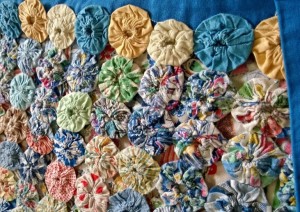
The first quilt we repack was made for a local school headmaster by the pupils using the Suffolk puff technique, and is from the 1930’s.
T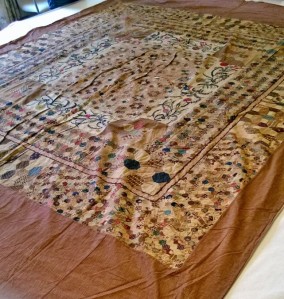 his second quilt has a wonderful cross-section of fabric patterns dating from the early 1800’s and beautiful crewel work embroidery, but has unfortunately suffered slightly from folding, and has developed wrinkles in the patchwork.
his second quilt has a wonderful cross-section of fabric patterns dating from the early 1800’s and beautiful crewel work embroidery, but has unfortunately suffered slightly from folding, and has developed wrinkles in the patchwork.
Rolling is a very effective way of storing flat fabric items, preventing creasing, and wear from folding, and in creating a protected environment for the fabric. So we now store large textile items such as quilts and tapestries rolled, like this …
White gloves on again, and we begin the careful process of wrapping the fabrics in rolled layers of melanex, acid free tissue paper, calico and wadding around large plastic tubes. It takes some practice to roll these straight, but it is worth doing right. As we roll, the quilts are constantly smoothed, to try and ease out wrinkles and creases.
The tapestries are fragile, and we have to re-locate them from a different store. At the same time, we bring back mannequins for a new display to go up in the museum in a few weeks. One of the dresses planned has a 22 inch waist, but is still so small that it needs one of our smallest available mannequins. The return journey loosely resembles the three wise men; as we carry our odd collection of items. I am holding the tapestry gingerly in front of me like an offering, because the hessian is so fragile, and the mannequins in their black bags attract some funny looks from passers-by!
We also spend time making loose covers for some of the larger sculptures in the art stores. One of the bronze statuettes; George and the Dragon by Paul Bocquillon, c. 1870-1880 has just gone into a new display opposite the reception desk, and needed a delicate clean using a museum vacuum and a soft, dry paintbrush to take off the dust.
From the small details to the bigger conservation jobs, collections care is a curious combination of monitoring, storing and cleaning; long term maintenance and short term projects are all part and parcel. Keeping the museum rolling!
THe Shed – More Life, Laws and Legacies
THe Shed in Tullie House may now be closed but there’s still chance experience the Tudor themes from the last exhibition. Our original Tudor building the ‘Guildhall’ is open for this week of the school holidays and again in May for the summer.
Eloise shares with us some information about the final Shed exhibition and the Guildhall.
The final shed exhibition, Life, Laws and Legacies has ended with the Mayor and Mayoress coming to re-open our treasured Guildhall Museum, which is the third oldest building in Carlisle after the Castle and Cathedral.
For those of you who missed seeing the City’s wonderful Dormont Book, there is a copy of the weird and wonderful old laws kept in the Guildhall, where you can see some of our treasures from Carlisle’s Tudor past.
You can see the huge iron bound Muniment chest where the City’s documents and treasure were stored, and also the world’s oldest sports trophies are housed in the Guildhall Museum.
These horse racing bells date from 1599 and older, and were given as prizes by the Tudor mayor and Lady Dacre.
Come and explore this beautiful oak beamed building, with its wattle and daub walls, and feel like you can step back in time. The men who signed the Dormont Book sat in these very rooms nearly 450 years ago.
Isaac Tully, whose family built Tullie House was a member of the merchants guild here. He still owes the Guild 40 shillings fine for allowing his sister to work in his shop!
So overall, are we really just terribly Modern Tudors? Well, yes, I think we might be!



